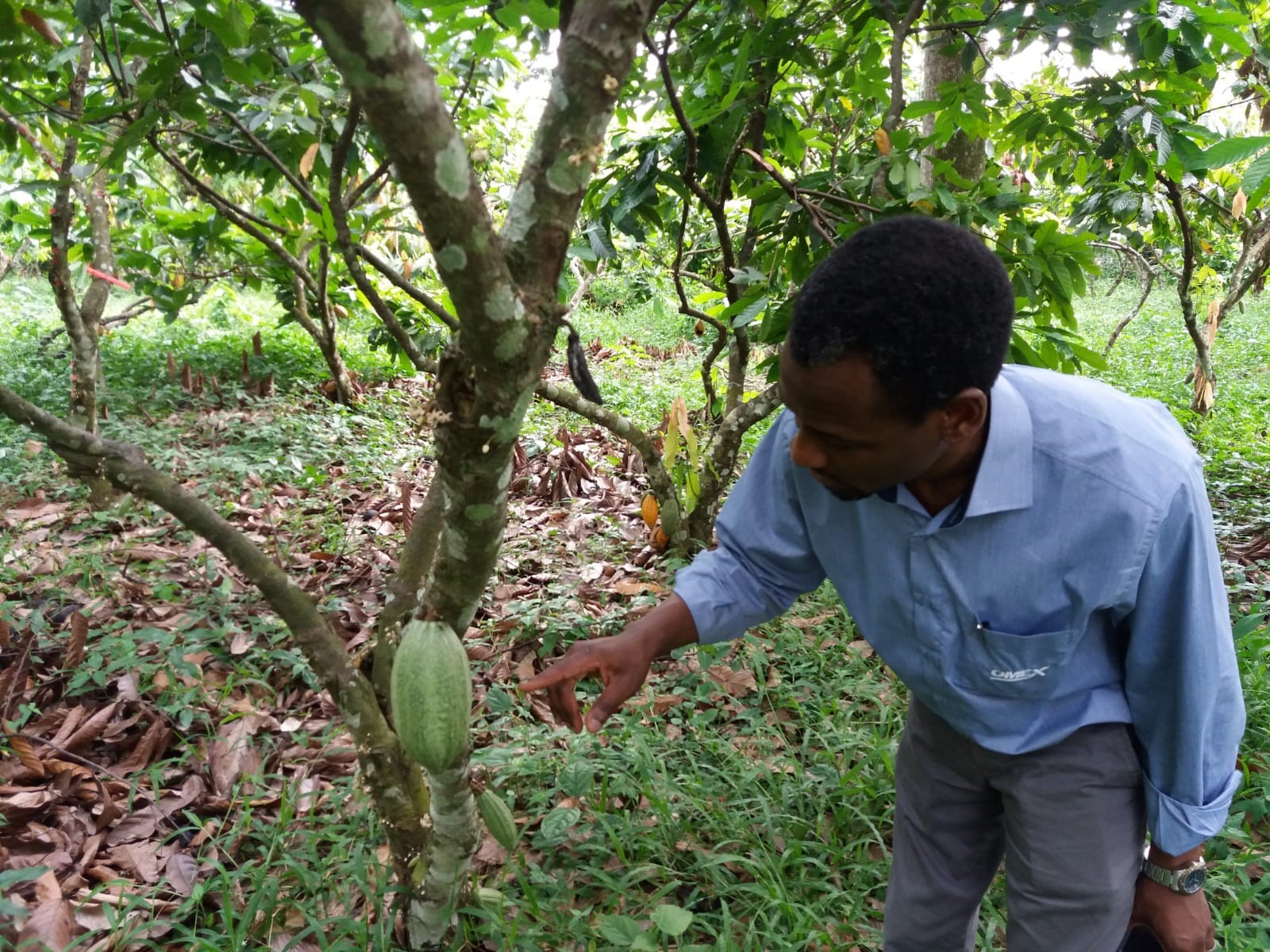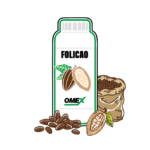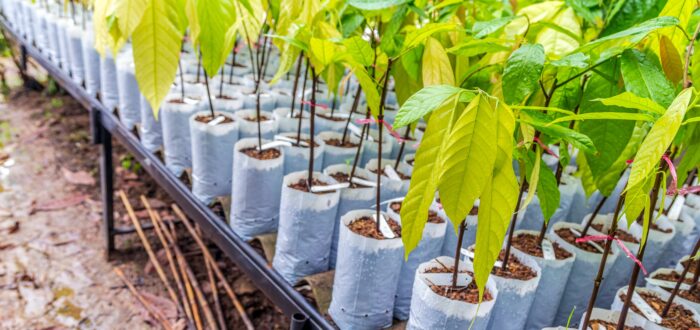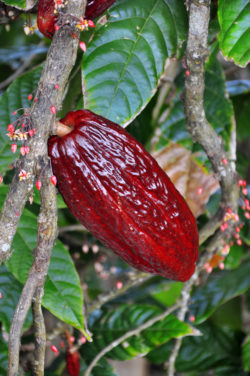
The Unique Challenges of Cocoa Production
AS A NATIVE species in the Amazonian rainforest understory, Theobroma cacao is a super shade loving tree, and grown as a monoculture crop throughout the Equatorial tropics. You might think cocoa is an easy crop to cultivate, with growers simply planting the trees and picking the pods, but nothing could be further from the truth.
Apart from being plagued by Phytophthora and enveloped by epiphytes, which thrive on the high humidity created by the intense rainfall and deep shade, cocoa and cocoa growers are presented with potential nutritional problems.
The deep leaf litter which accumulates beneath the cocoa canopy creates a barrier to the availability of base fertiliser applied as solid formulations to the ground, while high rainfall conditions can pose problems with leaching. These are most certainly the main reasons why agronomists have consistently failed to obtain a perpetual positive performance and response to base fertiliser treatments ever since cocoa was first grown as a commodity crop.
The Advantages of Foliar Feeding
Foliar fertilisation by spraying solutions of soluble nutrients onto the leaves using nutrient product profiles and application timing synchronised with growth and development of the cocoa tree crop is the obvious way forward.
Cocoa is grown throughout the wet and humid tropics but the single biggest hub of cocoa production now centres on the lowland areas of coastal West Africa. So, who better to speak with about cocoa production and the use of fertilisation by foliar spraying than Dr. Ben Odunlami, technical manager for Africa at OMEX Agrifluids, a global player in research, development and marketing of fully water soluble suspension fertiliser and soluble powder delivery systems (formulations).
I started by asking Dr. Odunlami about the cocoa-growing countries across West Africa where OMEX Agrifluids is actively involved. “We work alongside and together with distributors and cocoa growers in all cocoa-growing countries of Africa, both Anglophone and Francophone nations including Nigeria, Ghana, Côte D’Ivoire and Cameroun,” said Dr. Odunlami. OMEX is renowned worldwide for its comprehensive product portfolio, comprising soluble nutrient products designed to cater for almost every crop nutrition eventuality in the widest range crops. So, I asked Dr. Odunlami for an insight into the range of OMEX products applicable to and appropriate for cocoa in West Africa.
OMEX Bio 20: Nurturing Healthy Seedlings
Dr. Odunlami began with needs of nursery cocoa. “As with most other tropical tree crops seedling cocoa trees are raised in a nursery and planted in the field,” said Ben, adding how it is essential to nurture fast-growing, resilient trees with strong root systems to withstand transplanting and reach pod bearing development stage as quickly as possible. “Rapidly growing and resilient seedling root systems are achieved with foliar sprays of OMEX Bio 20 containing the trio of macronutrients – Nitrogen (N), Phosphorous (P) and Potassium (K) – together with magnesium (Mg) and a full range of micronutrients, most in chelated form. Moreover, OMEX Bio 20 features a biostimulant fraction sourced from a species of marine alga (seaweed).
Cocoboost and Folicao: Tailored Nutrition
I was keen to know whether OMEX had products custom-designed for specific use in cocoa. “Yes we do,” said Dr. Odunlami, who explained how OMEX had one designated product for use in Anglophone countries and another for cocoa growers in Francophone countries. “Cocoboost which is used in Ghana and Nigeria is a foliar applied product containing N, P and K at 8.30%, 32.40% and 21.10% w/v, respectively, chelated Mg and the full range of micronutrients – Iron (Fe), Manganese (Mn), Zinc (Zn), Boron (B), Cobalt (Co) and Molybdenum (Mo) and most in chelated form,” Dr. Odunlami told African Farming. Applications are timed from the start of pod development with five spray applications in total made to the foliage and fruit (pods) and at 21-day intervals. “Recommended rate is 2 litres (L)/product/ha mixed at 40 ml in 15 L water,” said Dr. Odunlami.“We have developed the same type of ‘broad-base’, ‘broadbrush’ product for Francophone countries like Cote d’Ivoire and Cameroun,” said Ben. Folicao (Engrais Foliare pour Cacaoyers) – Foliar fertiliser for cocoa contains N, P and K at 13.50%, 27.00% and 27.00% w/v, respectively with Mg and the same full spectrum of micronutrients contained in Cocoboost. Folicao is applied as a spray to the foliage during periods of active growth. Applications should be made every 10-14 days to trees showing any nutrient deficiency. The OMEX recommended rate is 2.0-4.0 L/ha mixed at 30-60 ml/15 L water.
OMEX Zibo: Strengthening Cocoa Trees
Of particular interest is OMEX Zibo, one of the company’s newest products. OMEX Zibo was initially designed and developed for coffee, but is now used on a wide of range tree crops, especially cocoa. Containing Zinc (22.10% w/v) and Boron (7.30% w/v), Zibo was specifically designed with a ratio of Zinc to Boron that most closely matches the requirement for these two essential micronutrients by tree crops like cocoa and coffee. Zinc and boron both have key strengthening-related roles in the synthesis of cell wall material as well as the transport of soluble sugars.
“Pollination success is greatly influenced by the availability of Boron,” said Dr. Odunlami, adding, “how application timing is therefore synchronised with the onset of flowering in cocoa.” An initial application made at the pre-flowering stage, and during the tree’s initial growth flush, is followed up and sustained with a repeat application made four weeks later. OMEX Zibo is used at a concentration of 60 ml product/20 litres of water and at a rate of 0.5-1.0 litre of product/ha.
OMEX CalMax: Supporting Pod Growth and Yield
 However, the single most strategically important nutrient for plant tissue strength and stability is calcium as calcium pectate, the gelatinous material forming the middle lamella and cementing cells together. Dr. Odunlami told African Farming how OMEX CalMax containing 22.5% w/v soluble calcium is recommended as a frequently applied foliar spray to provide good pod growth and bean yield as well as structural support within the entire cocoa tree.
However, the single most strategically important nutrient for plant tissue strength and stability is calcium as calcium pectate, the gelatinous material forming the middle lamella and cementing cells together. Dr. Odunlami told African Farming how OMEX CalMax containing 22.5% w/v soluble calcium is recommended as a frequently applied foliar spray to provide good pod growth and bean yield as well as structural support within the entire cocoa tree.
Phosphite-Based Disease Management
I asked Dr. Odunlami about the perennial problems of yield loss and even tree mortality caused by the combined effects of Phytophthora pod rot and Phytophthora stem canker disease, the single biggest limiting factor operating against commercial cultivation of cocoa. These diseases have traditionally been managed using chemical fungicides but increasing scrutiny on all-round safety of chemical pesticides is leading, slowly but surely, to a phased withdrawal.
Being well aware of the company’s interest in a nutrient-based alternative for Phytophthora management, I asked Dr. Odunlami to expand on the company’s interest. “Our key interest is in the development of phosphite (soluble salt of phosphorous acid) as a so-called elicitor which generates a metabolic response in the host plant (cocoa) for suppression of disease. “To this end, we already have a phosphite-containing product called OMEX DP98 which can be used as a foliar spray, a root drench or for direct application of stem cankers on the trunk and branches of the cocoa tree,” said Dr. Odunlami.
In conclusion, foliar feeding offers an innovative and effective solution for cocoa growers facing the challenges of nutrient deficiencies, disease, and environmental factors. By applying soluble nutrient solutions directly to the leaves of cocoa trees, growers can enhance nutrient uptake, provide targeted nutrition, and achieve quicker responses compared to traditional fertilization methods. OMEX Agrifluids, with its range of custom-designed foliar fertilizers, is at the forefront of supporting cocoa production in both Anglophone and Francophone countries. Whether it’s nurturing healthy seedlings, tailoring nutrition to specific regions, strengthening tree structures, or exploring nutrient-based disease management, OMEX Agrifluids provides the necessary tools for cocoa growers to maximize their yields and foster sustainable cocoa production.
Article by: Dr. Terry Mabbett in conversation with OMEX Agrifluids’ technical manager for Africa, Dr. Ben Odunlami providing insight on cocoa production and the benefits of using fertilisation by foliar spraying.


